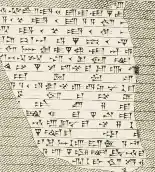Azekah Inscription
The Azekah Inscription, is a tablet inscription of the reign of Sennacherib (reigned 705 to 681 BC) discovered in the mid-nineteenth century in the Library of Ashurbanipal. It was identified as a single tablet by Nadav Na'aman in 1974.
| Azekah Inscription | |
|---|---|
 The text of the first fragment discovered (K.6205), published in Rawlinson's editio princeps | |
| Material | Clay |
| Writing | Akkadian cuneiform |
| Created | c.700 BC |
| Discovered | Mid 19th century. Combined identification in [1903] |
| Present location | British Museum |
| Identification | K.6205 + BM 82-3-23,131 |
It describes an Assyrian campaign by Sennacherib against Hezekiah, King of Judah, including the conquest of Azekah.
Inscription
The inscription on the combined tablet has been translated as follows:[1][2]
(3) […Ashur, my lord, encourage]ed me and against the land of Ju[dah I marched. In] the course of my campaign, the tribute of the ki[ng(s)...
(4) […with the mig]ht of Ashur, my lord, the province of [Hezek]iah of Judah like […
(5) […] the city of Azekah, his stronghold, which is between my [bo]rder and the land of Judah […
(6) [like the nest of the eagle? ] located on a mountain ridge, like pointed iron daggers without number reaching high to heaven […
(7) [Its walls] were strong and rivaled the highest mountains, to the (mere) sight, as if from the sky [appears its head? …
(8) [by means of beaten (earth) ra]mps, mighty? Battering rams brought near, the work of […], with the attack by foot soldiers, [my] wa[rriors…
(9) […] they had seen [the approach of my cav]alry and they had heard the roar of the mighty troops of the god Ashur and [their] he[arts] became afraid […
(10) [The city Azekah I besieged,] I captured, I carried off its spoil, I destroyed, I devastated, [I burned with fire…
(11) [ ], a royal ci[ty] of the Philistines (Pi-lis-ta-a-a), which [Hezek]iah had captured and strengthed for himself
Transliteration
Na'aman's transliteration of lines 3, 4, 5 and 11 is shown below:[3]
(3) [… AN.SAR béli u-tak-kil-a] n-ni-ma a-na KUR Ja-[u-di lu al-lik ina] me-ti-iq KASKAL II ja man-da-at-tu sa LU [GAL MES KUR…. amhur….
(4) […ina da-n] a?-ni sa AN.SAR EN-ja na-gu-u [sa mHa-za-qi-j] a-a-u KUR Ja-u-da-a-a GIM […
(5) [… ] URU A-za-qa-a E tuk-la-te-su sa ina bi-ri [t mi-i] s-ri-ja u KUR Ja-u-di [… v
(11) [URU GN URU] LUGAL-ti sa KUR Pi-lis-ta-a-a [sa] [m] [Ha]-[za-qi-j] a-a-u e-ki-mu u-dan-ni-nu-su-ma […
Winckler suggested the text referred not to Judah but to "Yadiya" (Sam'al)[4]
External links
- (Editio princeps) Nadav Na'aman, Sennacherib's "Letter to God" on His Campaign to Judah, Bulletin of the American Schools of Oriental Research, No. 214 (Apr., 1974), pp. 25–39. Also at JSTOR
- Galil, Gershon. “A NEW LOOK AT THE ‘AZEKAH INSCRIPTION’” Revue Biblique (1946-), vol. 102, no. 3, 1995, pp. 321–329
- The Inscription tablet in the British Museum
- Ancient Israel and Its Neighbors: Interaction and Counteraction
- Biblical Archaeology: Documents for the British Museum: Document 31
- SARGON'S AZEKAH INSCRIPTION: THE EARLIEST EXTRABIBLICAL REFERENCE TO THE SABBATH?
References
- Shadow on the Steps: Time Measurement in Ancient Israel, David Miano, p.235
- Milk and Honey: Essays on Ancient Israel and the Bible in Appreciation of the Judaic Studies Program at the University of California, San Diego, Editors: Sarah Malena, David Miano, p.126
- Na'aman
- "Archived copy" (PDF). Archived from the original (PDF) on 2013-10-02. Retrieved 2013-09-29.CS1 maint: archived copy as title (link)
